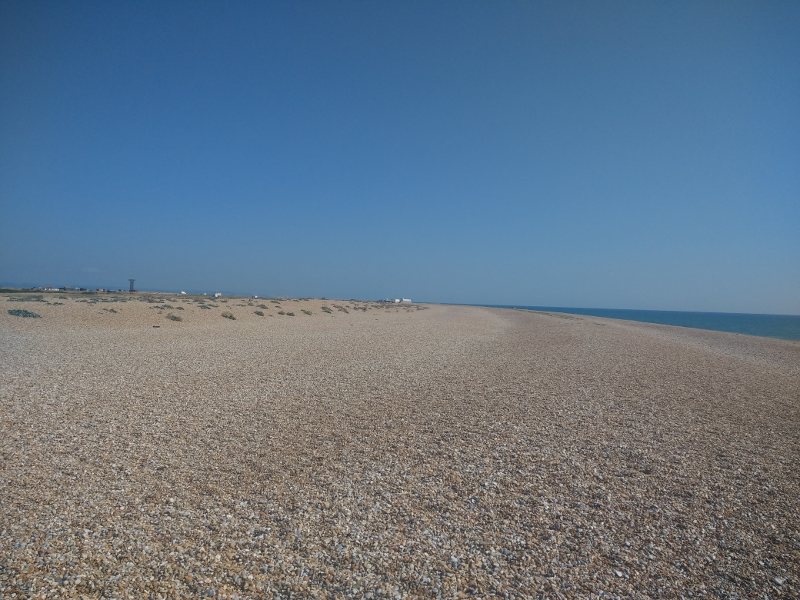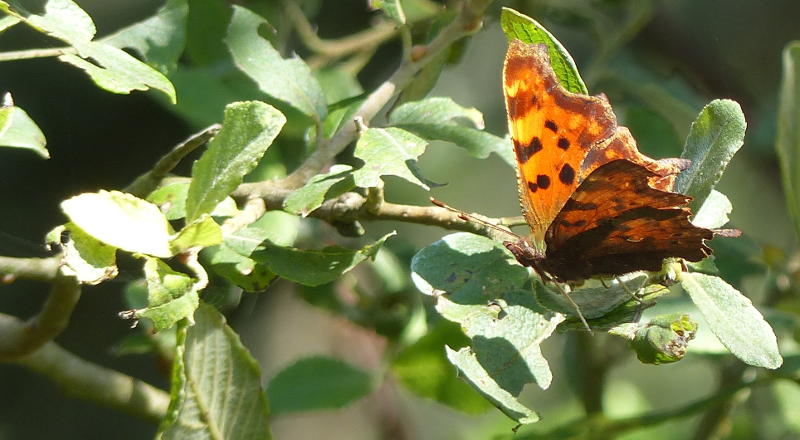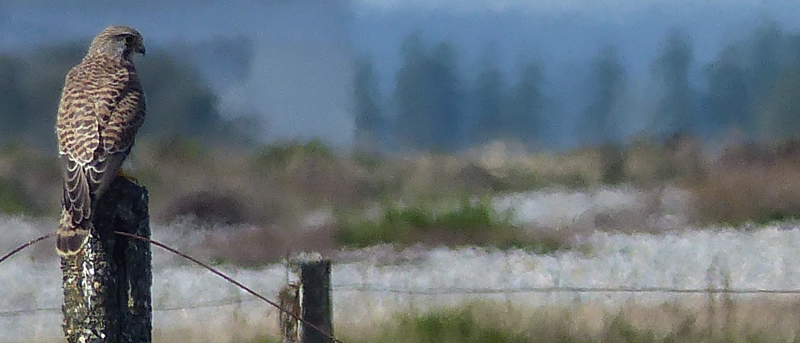Average Birding

Dungeness
September rolls round and I am blessed with a renewed resolve. Through good behaviour and a cunning deployment of miniature railways, I also am gifted with an AB2 who is prepared to try a Dungeness outing.
Pronoun guidance: AB1's resolve is renewed. This post covers the events of the 1st September, 2018.
A distant carrot
It's a good job there's a miniature railway involved - the journey would be unsellable otherwise - Northern to Pancras, HS1 and change to tiny Kentish station (tm), taxi, and finally, Romney, Hythe and Dymchurch railway for the final leg. It really is a remarkably small train! Exactly (really? -Ed) half-way between Hornby and actual train.
You sit in pairs, on mildly uncomfortable seats. There's possibly a foot of headroom on cars that are roofed. Views over the surrounding countryside are good, but not particularly elevated! No trolley service, but one of the middle stations has ice creams on the platform. Smart.
As well as being small, the train is slow - it takes 75 minutes to traverse the 20 odd miles to Dungeness. My inner cyclist is itching at such a slow pace, particularly when I see several railway-side paths aggressively labelled as not for cycling.
Dungeness arrival
We arrive in Dungeness. It is seriously hot. It is also perilously close to lunchtime, and once we set off on our walk the opportunities for food will be rather limited. We dive into a nearby pub (The Britannia Inn) for a rapid fish and chips, and easily the worst pint of the year so far. Kentish pubs. Sort your pipes out. Shepherd Neame. Sort your beer out.
The sea and the desert
Post pub, we give the sea a brief staring at. Nothing of note. The famed sewage outlets are sufficiently gulled, but not by any species of particular distinction.

We turn inland, heading for the bird observatory. Plenty of activity there, but unfortunately, all of it is human - lots of people looking, and not finding. A few are mucking about with nets.
A conversation or two yields no exciting news - the rough 'desert' ENE of the observatory has apparently had a group of Whinchat in it. The internet has also told tale of several Lesser Whitethroat. We shall see.
We head in that general direction and immediately encounter Wheatear. Always a pleasure. It finds several Wheatear compatible perch points: old concrete block, tick; railway sleepers, tick; patch of grass near a fence, tick. Lovely.
Next, we descend into a strip of trees. These are almost entirely silent. No movement. We hurry on through, a single Common Whitethroat our only accompaniment.
The path, such as it is, opens out into less densely shrubbed scrubby stuff. This is chat territory. Off to the left there are several watercourses, and some bramble encrusted willows bordering. Several tit flocks are peeping their way along them.

Nothing much else happens for at least a kilometre, and then everything kicks off. One or two Stonechats multiply into many more, perhaps getting into double figures. We check them diligently for Whinchat - having been starved of anything to look at we've got plenty of focus to spend. Several Common Whitethroat are sharing the same tangled shrubs, so we get stuck here for several minutes.
A pair of Whinchat are eventually differentiated - and they're in pretty good nick - noticeably cleaner than the birds we saw in Scotland. Still not the pinnacle of Whinchat occurrences though - I'm mindful of a trip to Wanstead where we saw seven in the space of a couple of minutes, at considerably closer quarters and (just as importantly) less far from home!
I take a brief break from chats and give the treeline running parallel to the waterline a bit of a look. There's a couple of birds making their way along it; more Common Whitethroat? A look through the bins...does not confirm. They might even be Lesser Whitethroat, you know - there's none of the warm colour palette common would have.
They're rather too far away to be sure. The pair seem unfazed by our approach, so, after a brief attempt with the scope, we get near enough to pick out the details just with the binoculars. Yep. Lesser Whitethroat. They exist. That wasn't even difficult. Apart from the three plus hour journey to get here, and the fact that we're in Britain's only desert, on one of the year's hottest days. Easy.
Road to hell
We eventually exit the desert on to the main road that leads to Dungeness RSPB. This road is miserable - straight, flat, exposed, featureless and with nowhere for pedestrians, and therefore not at all safe. I have walked it once before in almost opposite conditions - wet, cold, and blowing a gale and I struggle to say which was worse. Amusingly, that other walk was for the same bird - Cattle Egret.
This time, the bird has been reported on the RSPB reserve; previously I had to skulk across the reserve and then up to some farm buildings even further away. There should even be time to do a quick circuit of the reserve in question, although, eesh - given how long it's taken us to get here, it'll have to be rapid. The RSPB map reckons we need an hour.
RSPB Dungeness
That should be plenty; while the reserve is well-maintained and has some excellent hides, it is often better in the Winter, when it boasts spectacular wildfowl numbers. We briefly tarry in one of the hides and spot a pair of Black Tern (so glad to have spent a day failing to get a view half this good on the Thames the other week) and admire a flock of hirundines feasting in the sunshine. And, to be honest, enjoy walking along something that isn't that bloody road.
The end of our circuitous walk brings us back to the reserve's entrance track. We've walked this one-way already. Now for the return journey. Cattle Egret, can, apparently, be found with the cattle off to one side of the entrance track. We gave this field a decent look on the way in, but, to be completely honest, were too much in need of refreshment to look properly.
I suspect we'll have more luck now - two cars are parked up on the track, and a group well-equipped with 'scopes is gathered near them. We set up camp within earshot and tune in to what appear to be the primary birder's commentary. The egret is, apparently, moving with the cattle, from right to left. At the moment, it's obscured by two or three cows. There are hints of it between legs now and again - a flash of white in a sea of yellows and greens. Eventually the gaps between cows is perfect, and the whole bird is visible.

Ok, excellent, great. Unfortunately, we have to go; less than an hour remains before the last train back to civilisation, and according to Google Maps it will take us three quarters of an hour to get there. Along that sodding road again. Ugh. I hypnotise myself into a marching rhythm, only interrupted by an excellent fencepost Kestrel.
Eventually we make it back to the miniature railway terminus, and recover from our latest baking with a fizzy drink. We bag seats in one of the open-top cars on the way back, which cools us off nicely.

Conclusion
That was hard work. Trying to do both the NNR and the RSPB reserve using the railway was a bridge too far - neither really got the attention they perhaps deserved. We totally ignored the sea bar a very quick look, too. I leave with the same impression as last time, that this site would be better experienced in a car, having stayed in a place not too far away.